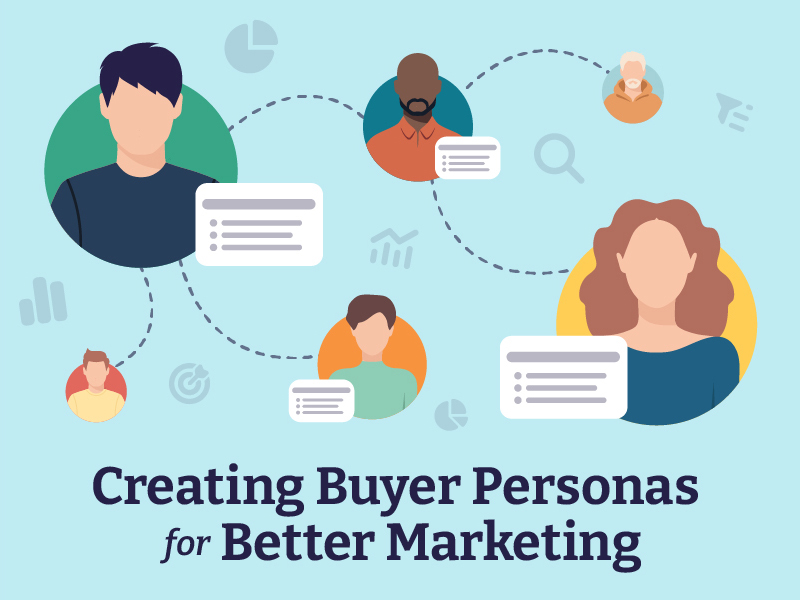Perhaps you’ve heard the phrase, “Be the ball, hit the ball.” If not, it’s in reference to baseball and it’s basically a somewhat Buddhist approach to the psychology of hitting the ball. The “oneness” alluded to may at first glance seem a bit fluffy, but there is powerful logic therein. Seeing the process of hitting this way simplifies the process for the hitter and injects a necessary confidence into all of the movements that make up a power
A version of this thinking applies to marketing as well: in the form of buyer personas. Creating buyer personas is often talked about – and deservedly so – as a way to guide content creation and marketing strategies. It’s an attempt to get inside the minds of the consumers you are marketing towards and no, it does not involve ESP.
To carry this out effectively, you have to go deeper into detail than you might have ever considered necessary. This is the part of the process that many small business owners aren’t willing to follow through with – this is a mistake.
I think that extensive detail can sometimes seem superfluous to business owners because it is, ultimately, being funneled into a depiction of a fictitious entity. In other words, people think about buyer personas and get wrapped up in the idea of creating a (preferably alliterate) name, attaching a stock photo, and throwing together some attributes. The only element of this process that is fictitious, though, is the fact that the attributes are being presented in aggregate form: the averaged out result of many different threads of empirical evidence.
This should not discourage persona building! These steps in the process are only the organizational element! The true meat of the technique is in the research. Let’s talk about how that research process should look and why it can be so effective:
Hypothetical Questions = Real World Answers
As with any investigatory pursuit, you need to start by asking questions. In this case, the questions will be thought of in the voice and mindset of your consumers. As you’re doing this, you’ll automatically start engaging yourself in the pursuit of answers for those questions. There’s nothing imaginary, though, about the results you get from this exercise!
Use whichever analytics platform you prefer to go through the information you have from leads and customers you’ve already acquired and see what that data indicates is important. Are there patterns emerging? Likely there will be, and once you start to pinpoint where they are, you can group them into personas.
For example, let’s say you are seeing many of your recent website leads have stopped reading a piece of content at a particular point. How can this affect the process of creating buyer personas? Well, think about what is being addressed at that point in the content. It will indicate what type of pain point is being missed, and what type of person would have that pain point. The next time you’re at the drawing board coming up with content ideas, address it in a clearly defined way. You’ll be pointedly attracting a portion of your consumer base that you had previously been missing.
Don’t forget: if finding these common pain points can be a struggle or seem inefficient for developing strategy at first, press on! Like anything, the hardest part of developing buyer personas is getting started. Once you have enough information catalogued, you’ll be able to see exactly what types of content are most effective, and couple that data with the appropriate personas.
Getting to Know Your Data
So, we know that acquiring data about your business is how you adapt and improve. The data is what tells you where you are headed, and gives you clues about what you can do to get where you want to be. But is the acquisition of that data enough?
Of course not.
Data needs to be molded and catalogued into a useful and interpretable resource. Buyer personas are a great way to approach this. In other words, the end results (the buyer personas you come up with) aren’t the only thing making the exercise worthwhile. The process of researching those personas will provide you with the perfect template for categorizing and internalizing what the streams of data are trying to tell you.
As you funnel patterns of data about a CTA’s success rate into a persona for whom it is especially effective, you’ll become better at making CTA’s in general. As you funnel patterns of data about a time of day in which your website gets most activity into a persona who is most apt to become a lead at that time, you’ll become better at optimizing the chronological structure of your content. Thinking about (and, frankly, just spending time with) your data in this way will increase your familiarity with not just your customer base, but also the value you provide to them and the best way to deliver it.
The particular method with which you organize that data into personas is up to you, but there are some tools that are especially helpful along the way. Our checklist, for example, is a great tool for making sure your persona building isn’t missing any key components. Also, Hubspot has a great tool for creating your own.
Personification is Key
While developing personas, you’ll need to dig deeper than you ever thought possible. Seriously! The body of evidence you’re drawing from will only gel into meaningful personas if you use all of those little minute details available. Think about how a day in their life might typically go. Are they spending time on your website during only certain hours of the day? Are they accessing content only at work or during leisure hours as well?
Often, business owners wonder whether it is really necessary to take that data and mold them into avatars of consumers. Once you have the data, why would you need to dress it up with a name and a profession?
This line of questioning misses a crucial point, though. The naming aspect is not a matter of “dressing up”, but a matter of consolidation. Think of all the different types of data you’re dealing with – simple demographic info, personal life details, buyer’s journey status, etc. -grouping them into named, identifiable entities is what makes your research worthwhile. Because of that consolidation, you’ll be able to immediately recognize one or more of the ascribed patterns coming into play the next time you come across a lead. Because you’ve already done the work of determining what types of marketing works best for each persona, that moment will be one of calculated action, not panicky snap judgment.
One of the best ways to get the most out of this type of personification is to monitor the online conversations that pertain to your industry. You can do this via hashtag monitoring on Twitter and Facebook. Also, don’t forget about tools like TweetDeck, Hootsuite, and Mention.
Recap
The importance of having intimate knowledge of your customer base has always been a part of marketing. Focus groups have been used for decades as a way to try and get inside their minds and use findings to personalize marketing strategies. The platform of the internet allows us to get far more detailed and quantifiable data to represent those consumers’ mindsets and buying process. This new wealth of information though, can be daunting in its scope.
We need ways to funnel it into useful channels. Enter: buyer personas. This data-driven, empirical approach to consumer categorization illuminates the patterns within the data and lets you know which of those patterns is most effective for driving revenue. Inject as much specificity as possible, and reap the rewards.
Need help getting started on creating your buyer personas and defining that target audience? No worries! Download the worksheet below:






